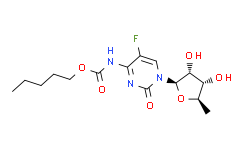| Cas No.: | 154361-50-9 |
| Chemical Name: | Capecitabine |
| Synonyms: | Capecitabine;Capcitabine;Pentyl (1-((2R,3R,4S,5R)-3,4-dihydroxy-5-methyltetrahydrofuran-2-yl)-5-fluoro-2-oxo-1,2-dihydr;5'-DEOXY-5-FLUOROCYTISINE;5'-DEOXY-5-FLUORO-N-[(PENTYLOXY)CARBONYL]CYTIDINE;RO-9-1978;pentyl [1-(3,4-dihydroxy-5-methyl-oxolan-2-yl)-5-fluoro-2-oxo-pyrimidin-4-yl]aminoformate;XELODA;CAPECITABINE USP32;Pentyl (1-((2R,3R,4S,5R)-3,4-dihydroxy-5-methyltetrahydrofuran-2-yl)-5-fluoro-2-oxo-1,2-dihydropyrimidin-4-yl)carbamate; 000;5'-Deoxy-5-fluoro-N4-[(pentyloxy)carbonyl]cytidine;Capecitibine;Capecytabine;Captabin;Cpecitabine;Ro 09-1978;5′-Deoxy-5-fluoro-N-[(pentyloxy)carbonyl]cytidine;Ro-9-1978;Pentyl [1-(3,4-dihydroxy-5-methyl-oxolan-2-yl)-5-fluoro-2-oxo-pyrimidin-4-yl]aminoformate;Xeloda;[ "" ];Chi Pei he;CAPECITABINE |
| SMILES: | CCCCCOC(NC1=NC(=O)N([C@@H]2O[C@H](C)[C@@H](O)[C@H]2O)C=C1F)=O |
| Formula: | C15H22FN3O6 |
| M.Wt: | 359.35008764267 |
| Sotrage: | 2 years -20°C Powder, 2 weeks 4°C in DMSO, 6 months -80°C in DMSO |
| Description: | Capecitabine is an oral prodrug that is converted to its active metabolite, fluorouracil (FU), by thymidine phosphorylase. |
| In Vivo: | A pharmacokinetic/pharmacodynamic study is carried out in mice bearing HCT 116 xenografts receiving 0.52 and 2.1 mmol/kg/d of Capecitabine by oral gavage. Capecitabine administered at 0.52 mmol/kg/day induces partial control of HCT 116 xenografts tumour growth: growth rate =7.5±0.5 on day 21. Capecitabine 2.1 mmol/kg/day achieves complete control of tumor growth during the treatment period: growth rate =1±0.2 on day 21[2]. |
| In Vitro: | Capecitabine is an anti-cancer chemotherapy drug. It is classified as an antimetabolite. Capecitabine is converted into 5′-deoxy-5-fluorocytidine (5′DFCR), 5′-deoxy-5-fluorouridine (5′DFUR) and 5-fluorouracil (5-FU) by carboxylesterases (CES1 and 2), cytidine deaminase (CDD), and thymidine phosphorylase (TP), in both liver and tumour. Capecitabine induces a significant cytotoxic effect in vitro only at high concentrations. Mean IC50 values vary from 860 μM in COLO205 cells to 6000 μM in HCT8 cells[2]. |

 To enhance service speed and avoid tariff delays, we've opened a US warehouse. All US orders ship directly from our US facility.
To enhance service speed and avoid tariff delays, we've opened a US warehouse. All US orders ship directly from our US facility.




















